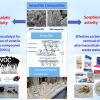Composites for the removal of pharmaceuticals from water and volatiles from the air
Technology description
| The name of the technology: | Composites for the removal of pharmaceuticals from water and volatiles from the air |
|---|---|
| Challenge: |
The issue of micropollutants of various types is gaining worldwide attention with regard to their actual concentrations, their impact on the environment and their removal options. These substances do not readily undergo biodegradation, are toxic by their nature and are potentially very harmful to the human body and the environment in general. Smectites, i.e. clay minerals, offer an interesting alternative for their disposal. They represent promising starting nanomaterials for the preparation of environmentally friendly catalysts and efficient sorbents with predefined properties and a wide range of applications. |
| Description: |
We present new composites based on clay minerals, which will be applied as effective sorbents in wastewater treatment and in the development of new types of ecological catalysts for the removal of organic pollutants from the air. Innovative composite materials were prepared by chemical treatment of the clay matrix. These exploit the ability of smectites to accept "guest" substances into their crystal structure, in combination with other properties. These include a large specific surface area, cation exchange capacity and chemical and mechanical stability. The resulting composites are effective catalysts for the removal of organic volatiles and model compounds of ethanol and toluene, respectively. And they have also demonstrated very efficient sorption capabilities for selected drugs (analgesics, antibiotics) as well as enhanced thermal stability. |
| Commercial opportunity: |
• Proven effective in wastewater treatment and air protection. • We offer the use of our know-how in the targeted design, preparation and characterization of modified layered silicates. • The new smectite-based composite materials will be applied in a number of fields for innovative solutions to current problems, whether it is the development of new types of eco-catalysts to improve air protection or the preparation of selective sorbents for the remediation of aquatic environments. |
| IP protection status: | know how |
| Development status: |
Phase 2Corresponds with TRL 3 and TRL 4 Feasibility study. There is a realistic design of the technology and the initial tests in the laboratory are leading to the specification of the technology requirements and its capabilities.
|
| Partnering strategy: | Co-development Collaboration |
| More information: | We are looking for partners to collaborate on downstream development and testing in a relevant environment. These include the use of efficient sorbents for the removal of pharmaceuticals from wastewater and where effective catalysts can be used for the oxidation of volatile substances. |
| Images: | |
| Categories: | Chemistry Environment and Climate |
| Owner of a technology: |


